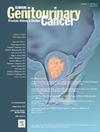新病变的出现与 Pembrolizumab 治疗尿路上皮癌的不良预后有关。
IF 2.3
3区 医学
Q3 ONCOLOGY
引用次数: 0
摘要
研究目的本研究调查了接受pembrolizumab治疗的尿路上皮癌患者的反应模式变化,包括靶病灶扩大和新病灶的出现,并评估了新病灶对患者预后的影响:这项回顾性分析纳入了铂类治疗失败后接受pembrolizumab治疗的尿路癌患者。实体瘤反应评价标准用于评估靶病灶大小和新病灶的出现。患者被分为两组:原发性进展性疾病(PD)组,包括治疗开始后28至84天内出现进展的患者;继发性进展性疾病组,包括治疗开始后超过84天出现进展的患者。研究人员进行了生存分析,以评估新病变对患者预后的影响:在这项研究中,42 名患者经历了原发性 PD,37 名患者经历了继发性 PD。在原发性 PD 患者中,目标病灶大小增加 20% 或以上、新出现病灶以及目标病灶大小和新病灶同时增加的患者分别占 64.3%、73.8% 和 45.2%。Kaplan-Meier分析显示,原发性PD和新发病灶患者在PD后的总生存期明显短于仅有靶病灶增长的患者和继发性PD患者(P均<0.001):本研究揭示了尿路上皮癌患者在接受pembrolizumab治疗期间反应模式的异质性,以及原发性pembrolizumab耐药和治疗早期出现新病灶的情况。应尽早进行影像学评估,以评估新病灶的出现,从而进行序贯治疗。本文章由计算机程序翻译,如有差异,请以英文原文为准。
Appearance of New Lesions Associate With Poor Prognosis in Pembrolizumab-Treated Urothelial Carcinoma
Objectives
This study investigated the variations in response patterns, including target lesion enlargement and the emergence of new lesions, in patients with urothelial carcinoma receiving pembrolizumab therapy and assessed the impact of new lesions on patient outcomes.
Methods
This retrospective analysis included patients with urothelial carcinoma treated with pembrolizumab following platinum failure. Response Evaluation Criteria in Solid Tumors criteria were used to assess the target lesion size and appearance of new lesions. Patients were categorized into 2 groups: the primary progressive disease (PD) group, consisting of patients who progressed within 28 to 84 days of treatment initiation, and the secondary PD group, consisting of patients who progressed more than 84 days after treatment initiation. Survival analyses were performed to evaluate the impact of new lesions on patient outcomes.
Results
In this study, 42 patients experienced primary PD, and 37 experienced secondary PD. Among patients with primary PD, 64.3%, 73.8%, 45.2% had an increase of 20% or more in target lesion size, newly emerged lesions, and both an increase in target lesion size and new lesions, respectively. Kaplan–Meier analysis revealed that patients with primary PD and new lesions had significantly shorter overall survival after PD than those with only target lesion growth and those with secondary PD (both P < .001).
Conclusion
This study revealed the heterogeneity of response patterns during pembrolizumab therapy in patients with urothelial carcinoma and primary pembrolizumab resistance and the presence of new lesions early in treatment. Earlier imaging evaluation should be performed to assess for the appearance of new lesions, leading to sequential treatment.
求助全文
通过发布文献求助,成功后即可免费获取论文全文。
去求助
来源期刊

Clinical genitourinary cancer
医学-泌尿学与肾脏学
CiteScore
5.20
自引率
6.20%
发文量
201
审稿时长
54 days
期刊介绍:
Clinical Genitourinary Cancer is a peer-reviewed journal that publishes original articles describing various aspects of clinical and translational research in genitourinary cancers. Clinical Genitourinary Cancer is devoted to articles on detection, diagnosis, prevention, and treatment of genitourinary cancers. The main emphasis is on recent scientific developments in all areas related to genitourinary malignancies. Specific areas of interest include clinical research and mechanistic approaches; drug sensitivity and resistance; gene and antisense therapy; pathology, markers, and prognostic indicators; chemoprevention strategies; multimodality therapy; and integration of various approaches.
 求助内容:
求助内容: 应助结果提醒方式:
应助结果提醒方式:


